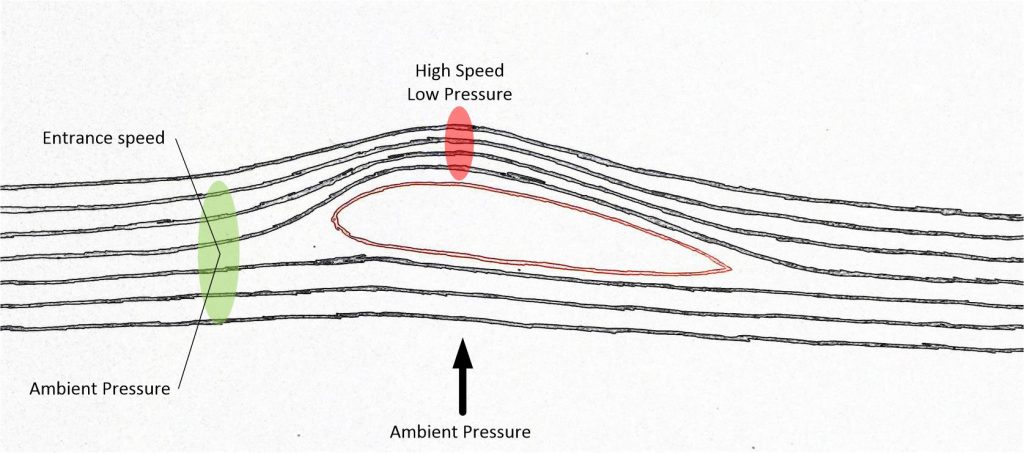Considering the physical fundamentals of hydrofoiling, we have to take a look at Bernoulli´s law. Daniel Bernoulli was a Swiss physicist and mathematician who explored the basics of flow mechanism with the Bernoulli equation in the 18th century. Venturi later improved the equation, better known as the Venturi effect.
Bernoulli’s law states that the specific energy on a thread of current is always constant. This energy consists of energy of pressure, energy of velocity and energy of location. Furthermore, Bernoulli found out that fluids will speed up if they reach a reduction.
That means, the pressure is high if the velocity of the fluid is low. On the other hand we can say, if the velocity of the fluid is getting higher, the pressure decreases.
This is the effect behind a flying airplane. The current on the upper side of the wing speeds up, therefore the pressure decreases. Now the ambient pressure in the surrounding lifts the airplane.
The same principal works on the wing of a hydrofoil.
The engineers of Woodboard applied this principal on their freeride boards.
Instead of a wing, the current on a kiteboard speeds up on a restricting channel towards the tip.
We already know, the water under the board speeds up in the reduction of the restricting channel, therefore the pressure under the board decreases and the ambient pressure helps to lift the board.
Using realistic numbers in Bernoulli´s equation, we calculated an additional uplift force of 1 up to 2 Newton. Which is equivalent to 10 up to 20 kg.
That basically means that the kite just needs to move 70 kg, even though the rider´s weight is 80 kg.
That’s the reason why the Woodboard CRBN and CHAME have such good riding abilities on low end, enormous upwind qualities and loose feeling on the feet.
We made this effect visible on digital flow simulations. With an inlet velocity of 6 knots (green), the current reaches an exit velocity of 9 knots (yellow).
To give a review:
Gliding with a “normal” twintip board
A volume flow hits an incline. The generated force separates in two components: the uplift force and the propelling force. If the uplift force is higher than the rider´s weight, the board starts gliding. The resulting force points upwards.
Gliding with a Bernoulli-Venturi shape
The restricting channel of the freeride boards Woodboard CRBN and CHAME speeds up the current additionally to the above shown relation of forces. Now the pressure under the board is lower than the ambient pressure of the surrounding. This effect generates an additional uplift force.
Comparing the needed uplift force of a normal board with a board using Venturi channels, we can immediately realize one thing: The board with Venturi channels needs less uplift force.
This effect makes the board glide early even in low wind situations, it rides upwind very easily and offers a loose feeling at the same time. Because there is less uplift force needed, the board can generate propelling force instead. This leads to more speed and a fast ride.







